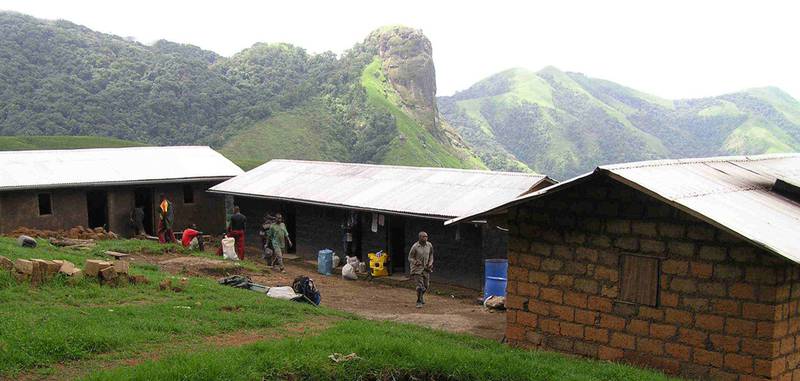Kagwene-Gorillas
Categories: Journal no. 36, Protective Measures, Cameroon, Kagwene, Cross River Gorilla, Gorilla Journal

The WCS research camp and eco-guard post perched on the forest edge at 1,800 m above sea level. Cross River gorilla monitoring and protection activities are coordinated from this camp. (© WCS, Aaron Nicholas)
The government of Cameroon announced on the 3rd of April 2008 the creation of the world's first sanctuary exclusively for the Cross River gorilla, and this is now added to the national portfolio of protected areas managed by the Ministry of Forestry and Wildlife.
The Kagwene Gorilla Sanctuary was officially created by decree of the Prime Minister of Cameroon, Ephraim Inoni, and was announced via national media. The creation of the sanctuary is the product of research and conservation action that was initiated in 2003 when researchers first realized the potential of Kagwene as a long term monitoring site for this elusive animal.
From the beginning, local community members were targeted for recruitment as gorilla monitors, and today 7 of the 9 villages surrounding the sanctuary are represented amongst the Wildlife Conservation Society (WCS) site-based staff who undertake daily monitoring and protection activities from a research camp perched high in the sanctuary on the forest edge at an altitude of 2,000 m.
Our knowledge of Cross River gorilla socio-ecology is largely restricted to studies that have been conducted in both Kagwene and the Afi Mountain Wildlife Sanctuary in Nigeria, both higher elevation gorilla sites. Such studies are emphasizing a number of differences between Cross River gorillas and the western lowland gorilla (Gorilla gorilla gorilla), related to factors including feeding ecology, ranging and nesting behaviour. Daily monitoring of the Kagwene gorillas continues, and further insights into how the estimated 20 gorillas make use of the 19.5 km² sanctuary and adjacent forest areas are still being made, especially in relation to group dynamics and habitat use.
Work done by Richard Bergl of the North Carolina Zoological Park has also confirmed that the gorillas found in Kagwene are genetically distinct from the 10 other known sites in Cameroon and Nigeria where Cross River gorillas are known to occur. Genetic and spatial analyses have also pointed to the likely presence of corridor areas linking Cross River gorilla sites such as Kagwene across the landscape, a research subject that is developing into the next main focal area to guide conservation action across the gorilla's landscape.
The creation of the Kagwene Gorilla Sanctuary is a further significant step towards securing a future for the remaining 250-300 Cross River gorillas. It is now expected that the Ministry of Forestry and Wildlife will post a Conservator and eco-guards to support the management of the sanctuary. None of this could have been achieved without the crucial support of our partners including WWF, the US Fish and Wildlife Service (who also provided funds for an administrative office and eco-guards' post in collaboration with Fauna and Flora International), the Gorilla Organization, the Margot Marsh Biodiversity Foundation, the Great Ape Trust of Iowa, the Boise Zoo, Berggorilla & Regenwald Direkthilfe and Columbus Zoo. The scene is therefore set for Ministry-led management action to now take place.
Aaron Nicholas


